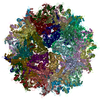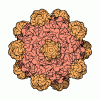+ Open data
Open data
- Basic information
Basic information
| Entry | Database: PDB / ID: 8tey | ||||||
|---|---|---|---|---|---|---|---|
| Title | Avian Adeno-associated virus - empty capsid | ||||||
 Components Components | Capsid protein Capsid Capsid | ||||||
 Keywords Keywords |  VIRUS / VIRUS /  Adeno-associated virus / Adeno-associated virus /  capsid / quail bronchitis / avianAAV / AAAV capsid / quail bronchitis / avianAAV / AAAV | ||||||
| Function / homology |  Function and homology information Function and homology information | ||||||
| Biological species |  Avian adeno-associated virus Avian adeno-associated virus | ||||||
| Method |  ELECTRON MICROSCOPY / ELECTRON MICROSCOPY /  single particle reconstruction / single particle reconstruction /  cryo EM / Resolution: 3.06 Å cryo EM / Resolution: 3.06 Å | ||||||
 Authors Authors | Hsi, J. / Mietzsch, M. / Chipman, P. / Afione, S. / Zeher, A. / Huang, R. / Chiorini, J. / McKenna, R. | ||||||
| Funding support |  United States, 1items United States, 1items
| ||||||
 Citation Citation |  Journal: J Virol / Year: 2023 Journal: J Virol / Year: 2023Title: Structural and antigenic characterization of the avian adeno-associated virus capsid. Authors: Jane Hsi / Mario Mietzsch / Paul Chipman / Sandra Afione / Allison Zeher / Rick Huang / John Chiorini / Robert McKenna /  Abstract: AAVs are extensively studied as promising therapeutic gene delivery vectors. In order to circumvent pre-existing antibodies targeting primate-based AAV capsids, the AAAV capsid was evaluated as an ...AAVs are extensively studied as promising therapeutic gene delivery vectors. In order to circumvent pre-existing antibodies targeting primate-based AAV capsids, the AAAV capsid was evaluated as an alternative to primate-based therapeutic vectors. Despite the high sequence diversity, the AAAV capsid was found to bind to a common glycan receptor, terminal galactose, which is also utilized by other AAVs already being utilized in gene therapy trials. However, contrary to the initial hypothesis, AAAV was recognized by approximately 30% of human sera tested. Structural and sequence comparisons point to conserved epitopes in the fivefold region of the capsid as the reason determinant for the observed cross-reactivity. | ||||||
| History |
|
- Structure visualization
Structure visualization
| Structure viewer | Molecule:  Molmil Molmil Jmol/JSmol Jmol/JSmol |
|---|
- Downloads & links
Downloads & links
- Download
Download
| PDBx/mmCIF format |  8tey.cif.gz 8tey.cif.gz | 5.2 MB | Display |  PDBx/mmCIF format PDBx/mmCIF format |
|---|---|---|---|---|
| PDB format |  pdb8tey.ent.gz pdb8tey.ent.gz | Display |  PDB format PDB format | |
| PDBx/mmJSON format |  8tey.json.gz 8tey.json.gz | Tree view |  PDBx/mmJSON format PDBx/mmJSON format | |
| Others |  Other downloads Other downloads |
-Validation report
| Arichive directory |  https://data.pdbj.org/pub/pdb/validation_reports/te/8tey https://data.pdbj.org/pub/pdb/validation_reports/te/8tey ftp://data.pdbj.org/pub/pdb/validation_reports/te/8tey ftp://data.pdbj.org/pub/pdb/validation_reports/te/8tey | HTTPS FTP |
|---|
-Related structure data
| Related structure data |  41209MC  8texC M: map data used to model this data C: citing same article ( |
|---|---|
| Similar structure data | Similarity search - Function & homology  F&H Search F&H Search |
- Links
Links
- Assembly
Assembly
| Deposited unit | 
|
|---|---|
| 1 |
|
- Components
Components
| #1: Protein |  Capsid CapsidMass: 60237.500 Da / Num. of mol.: 60 Source method: isolated from a genetically manipulated source Source: (gene. exp.)  Avian adeno-associated virus / Gene: Cap / Cell line (production host): HEK293 / Production host: Avian adeno-associated virus / Gene: Cap / Cell line (production host): HEK293 / Production host:   Homo sapiens (human) / References: UniProt: Q7TG43 Homo sapiens (human) / References: UniProt: Q7TG43#2: Chemical | ChemComp-DA /  Deoxyadenosine monophosphate Deoxyadenosine monophosphateHas ligand of interest | Y | |
|---|
-Experimental details
-Experiment
| Experiment | Method:  ELECTRON MICROSCOPY ELECTRON MICROSCOPY |
|---|---|
| EM experiment | Aggregation state: PARTICLE / 3D reconstruction method:  single particle reconstruction single particle reconstruction |
- Sample preparation
Sample preparation
| Component | Name: Avian adeno-associated virus / Type: VIRUS / Entity ID: #1 / Source: RECOMBINANT |
|---|---|
| Source (natural) | Organism:  Avian adeno-associated virus Avian adeno-associated virus |
| Source (recombinant) | Organism:   Homo sapiens (human) / Cell: HEK293 Homo sapiens (human) / Cell: HEK293 |
| Details of virus | Empty: YES / Enveloped: NO / Isolate: STRAIN / Type: VIRION |
| Buffer solution | pH: 7.4 |
| Specimen | Embedding applied: NO / Shadowing applied: NO / Staining applied : NO / Vitrification applied : NO / Vitrification applied : YES : YES |
Vitrification | Cryogen name: ETHANE |
- Electron microscopy imaging
Electron microscopy imaging
| Experimental equipment |  Model: Titan Krios / Image courtesy: FEI Company |
|---|---|
| Microscopy | Model: FEI TITAN KRIOS |
| Electron gun | Electron source : :  FIELD EMISSION GUN / Accelerating voltage: 300 kV / Illumination mode: FLOOD BEAM FIELD EMISSION GUN / Accelerating voltage: 300 kV / Illumination mode: FLOOD BEAM |
| Electron lens | Mode: BRIGHT FIELD Bright-field microscopy / Nominal defocus max: 3000 nm / Nominal defocus min: 400 nm Bright-field microscopy / Nominal defocus max: 3000 nm / Nominal defocus min: 400 nm |
| Image recording | Electron dose: 61 e/Å2 / Film or detector model: GATAN K2 QUANTUM (4k x 4k) |
- Processing
Processing
CTF correction | Type: PHASE FLIPPING AND AMPLITUDE CORRECTION | ||||||||||||||||||||||||
|---|---|---|---|---|---|---|---|---|---|---|---|---|---|---|---|---|---|---|---|---|---|---|---|---|---|
3D reconstruction | Resolution: 3.06 Å / Resolution method: FSC 0.143 CUT-OFF / Num. of particles: 11240 / Symmetry type: POINT | ||||||||||||||||||||||||
| Refine LS restraints |
|
 Movie
Movie Controller
Controller




 PDBj
PDBj




